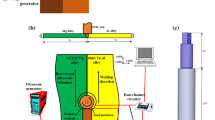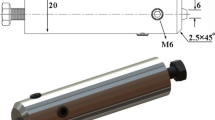Abstract
A new proposal for evaluating the relationship between the energy of vibration signals produced by a friction stir spot welding process and mechanical properties of dissimilar AA1050 H24 aluminum alloy–Cu lap joints is presented here. We characterized the vibration signals during the FSSW process to correlate them with microhardness and the failure load of the joints. The influences of dwell time and tool rotation speed on the mechanical properties of the join and its correlation with the energy of the vibration signals were studied. Macro images and microhardness maps of welds were also produced. The strong correlation found confirms that the energy of the vibration signals on the Z and Y axes can be used as an indicator of mechanical properties and as a novel method for weld evaluation. Finally, results based on numerical predictions are compared with the experimental failure load. The mathematical model obtained to calculate failure load values based on friction stir spot welding process parameters, also including the energy of vibration signals, improves the fit from 74.3% (with analyzed process parameters only) to 93.8% with the addition of the energy of the signal.














Similar content being viewed by others
References
Zhang Z, Yang X, Zhang J, Zhou G, Xu X, Zou B (2011) Effect of welding parameters on microstructure and mechanical properties of friction stir spot welded 5052 aluminum alloy. Mater Des 32:4461–4470. https://doi.org/10.1016/j.matdes.2011.03.058
Lathabai S, Painter MJ, Cantin GMD, Tyagi VK (2006) Friction spot joining of an extruded Al–Mg–Si alloy. Scr Mater 55:899–902. https://doi.org/10.1016/j.scriptamat.2006.07.046
Merzoug M, Mazari M, Berrahal L, Imad A (2010) Parametric studies of the process of friction spot stir welding of aluminium 6060-T5 alloys. Mater Des 31:3023–3028. https://doi.org/10.1016/j.matdes.2009.12.029
Heideman R, Johnson C, Kou S (2010) Metallurgical analysis of Al/Cu friction stir spot welding. Sci Technol Weld Join 15:597–604. https://doi.org/10.1179/136217110X12785889549985
Khan MI, Kuntz ML, Su P, Gerlich A, North T, Zhou Y (2007) Resistance and friction stir spot welding of DP600: a comparative study. Sci Technol Weld Join 12(2):175–182. https://doi.org/10.1179/174329307X159801
Cox CD, Gibson BT, Strauss AM, Cook JE (2014) Energy input during friction stir spot welding. J Man Proc 16(4):479–484. https://doi.org/10.1016/j.jmapro.2014.05.007
Chen C, Kovacevic R, Jandgric D (2003) Wavelet transform analysis of acoustic emission in monitoring friction stir welding of 6061 aluminum. Int J Mach Tools Manuf 43:1383–1390. https://doi.org/10.1016/S0890-6955(03)00130-5
Macías EJ, Roca AS, Fals HC, Fernández JB, de la Parte MP (2010) Time–frequency diagram applied to stability analysis in gas metal arc welding based on acoustic emission. Sci Technol Weld Join 15:226–232. https://doi.org/10.1179/136217110X12665778348588
Fernández JB, Roca AS, Fals HC, Macías EJ, de la Parte MP (2012) Application of vibroacoustic signals to evaluate tools profile changes in friction stir welding on AA 1050 H24 alloy. Sci Technol Weld Join 17:501–510. https://doi.org/10.1179/1362171812Y.0000000040
Macías EJ, Roca AS, Fals HC, Fernández JB, Muro JCS (2013) Neural networks and acoustic emission for modelling and characterization of the friction stir welding process. Rev Iberoam Autom Inform Ind 10:434–440. https://doi.org/10.1179/136217108X382981
Macías EJ, Roca AS, Fals HC, Muro JCS, Fernández JB (2015) Characterisation of friction stir spot welding process based on envelope analysis of vibro-acoustical signals. Sci Technol Weld Join 20:172–180. https://doi.org/10.1179/1362171814Y.0000000268
Bozzi S, Helbert-Etter A, Baudin T, Criqui B, Kerbiguet J (2010) Intermetallic compounds in Al 6016/If-steel friction stir spot welds. Mater Sci Eng A 527:4505–4509. https://doi.org/10.1016/j.msea.2010.03.097
Bozzi S, Helbert-Etter A, Baudin T, Klosek V, Kerbiguet J, Criqui B (2010) Influence of FSSW parameters on fracture mechanisms of 5182 aluminium welds. J Mater Process Tech 210(11):1429–1435. https://doi.org/10.1016/j.jmatprotec.2010.03.022
Xue P, Xiao BL, Wang D, Ma ZY (2011) Achieving high property friction stir welded aluminium/copper lap joint at low heat input. Sci Technol Weld Join 16:657–661. https://doi.org/10.1179/1362171811Y.0000000018
Barekatain H, Kazeminezhad M, Kokabi A (2014) Microstructure and mechanical properties in dissimilar butt friction stir welding of severely plastic deformed aluminum AA 1050 and commercially pure copper sheets. J Mater Sci Technol 30(8):826–834. https://doi.org/10.1016/j.jmst.2013.11.007
Smith CB (2007) Robots and machines for friction stir welding/processing. In: Mishra RS, Mahoney MW (eds) Friction stir welding and processing. ASM International, Materials Park, pp 219–233
Yin YH, Sun N, North TH, Hu SS (2010) Hook formation and mechanical properties in AZ31 friction stir spot welds. J Mat Proc Tech 210:2062–2070. https://doi.org/10.1016/j.jmatprotec.2010.07.029
Raju KR, Varma BM, Kumar NR (2013) Condition based maintenance (CBM) through vibration spectrum analysis for improving the reliability of B-1 conveyor (DIVE542) diagnosis of fault through vibration spectrum analysis technique. Int J Innov Tech Expl Eng 2(2):58–62
Luo Y, Li JL, Wu W (2013) Nugget quality prediction of resistance spot welding on aluminium alloy based on structureborne acoustic emission signals. Sci Technol Weld Join 18(4):301–306. https://doi.org/10.1179/1362171812Y.0000000102
Ouyang J, Yarrapareddy E, Kovacevic R (2006) Microstructural evolution in the friction stir welded 6061 aluminum alloy (T6-temper condition) to copper. J Mat Proc Tech 172(1):110–122. https://doi.org/10.1016/j.jmatprotec.2005.09.013
Murr LE, Li Y, Flores RD, Trillo EA, McClure JC (1998) Intercalation vortices and related microstructural features in the friction-stir welding of dissimilar metals. Mater Res Innov 2(3):150–163. https://doi.org/10.1007/s100190050078
Wang DA, Lee SC (2007) Microstructures and failure mechanisms of friction stir spot welds of aluminum 6061-T6 sheets. J Mat Proc Technol 186:291–297. https://doi.org/10.1016/j.jmatprotec.2006.12.045
Yuan W, Mishra RS, Webb S, Chen YL, Carlson B, Herling DR, Grant GJ (2011) Effect of tool design and process parameters on properties of Al alloy 6016 friction stir spot welds. J Mat Proc Technol 211:972–977. https://doi.org/10.1016/j.jmatprotec.2010.12.014
Acknowledgments
This work was partially supported by the project of the Spanish Government, DPI2011-25007. “Friction stir welding of dissimilar materials. Characterization by acoustic emission techniques and artificial intelligence.”
Author information
Authors and Affiliations
Corresponding author
Additional information
Publisher’s note
Springer Nature remains neutral with regard to jurisdictional claims in published maps and institutional affiliations.
Rights and permissions
About this article
Cite this article
de la Parte, M.P., Azofra, J.C., Fals, H.D.C. et al. A new way to predict the mechanical properties of friction stir spot welding for Al-Cu joints by energy analysis of the vibration signals. Int J Adv Manuf Technol 105, 1823–1834 (2019). https://doi.org/10.1007/s00170-019-04396-5
Received:
Accepted:
Published:
Issue Date:
DOI: https://doi.org/10.1007/s00170-019-04396-5




